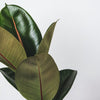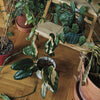Velvet beauties Anthurium
Velvet beauties with with dark leaves, these are Anthuriums. Like many other plants from the Araceae family, they come from the tropical rainforests of Central and South America. They are most often found in Colombia, Peru and Brazil, but also in other areas. These fascinating plants have gained popularity not only among collectors, but also in homes around the world, where they serve as wonderful houseplants. They caught the attention of growers in Europe as early as the 19th century, but their popularity returned significantly in the 1950s and 1960s.
Different types of Anthurium growth
Anthuriums can be divided into two main categories according to the way they grow:
- Epiphytic – These species grow naturally on trees where they do not parasitize, but rather use their ability to root in the air. Typical examples are Anthurium Crystallinum and Anthurium veitchii , which rely on moisture from their surroundings.
- Terrestrial – These species grow in soil and prefer an environment with diffused light. Some terrestrial species, such asAnthurium Luxurians , can have dark leaves with silvery hues, depending on the conditions under which they are grown.

Anthurium Luxurians
Light and its effect on growth
Anthuriums generally prefer diffused light, similar to their natural habitat of tropical forests where they grow under the treetops. However, it is not true that all anthuriums need a lot of light. Some species tolerate lower light intensity and can grow even in dark corners.
- Anthurium Papililaminum with dark, almost black leaves tolerates lower light intensity and is an ideal choice for shadier locations.
- Anthurium Ace of Spades has dark, heart-shaped leaves and will tolerate less light than its 'royal' counterpart, making it a great choice for slightly shady locations.
Conversely, species such as Anthurium Regale and itshybrids or Anthurium Warocqueanum require more intense diffused light to keep their leaves healthy and beautifully colored.
Watering: How much water do individual species need ?
Each species of Anthurium needs a specific approach to watering. For example, Anthurium Magnificum can handle short periods of drought, while species such as Anthurium Luxurians are more sensitive and wilt more quickly in the absence of moisture. The key to successful cultivation is checking the top layer of the substrate - water only when the surface is dry to a depth of 2-5 cm. In the summer you need to water more often, while in the winter it can be less.
Various leaves - velvety, structured, shiny
Anthuriums feature a wide variety of leaf appearances, from velvety to textured to glossy smooth leaves. These differences are the result of evolutionary adaptations to different environmental conditions.
- Velvet leaves ( A. Besseae Aff., A. Warocqueanum ) have dark, velvety leaves with distinct veining. This type of leaf is adapted to their environment, allowing them to better absorb available light. The velvet surface also helps to better retain moisture on the surface of the leaf.
- Textured leaves ( A. Veitchii ) have wavy, textured leaves that maximize surface area for photosynthesis. This type of leaf is typical of epiphytic species that grow at higher altitudes where they can get more light and moisture from the air.
- Glossy Leaves Although this article focuses on species with velvety leaves, some members of the genus Anthurium have glossy leaves. These species are adapted for higher light intensity and the glossy surface helps to reflect excess sunlight.
What is a suitable substrate?
Anthuriums prefer a very airy substrate that can dry out between waterings. We recommend a mixture for aroids , or a mixture for orchids , which contains activated carbon , which helps disinfect the substrate and prevent fungal diseases.
Choosing a flower pot
Choose transparent pots for orchids, or as tall as possible. Transparent ones are particularly suitable because they allow monitoring of the growth, condition and humidity of the substrate. Frequent inspection and repotting is important to prevent problems such as leaf drop or stunted growth.
How to recognize hybrid Anthurium?
You can recognize it, for example, by the shape of the stems:
-
Angular stems Some species of Anthuriums have distinctly angular or square stems. This trait is typical of certain epiphytic species, which have stronger stems to handle aerial growth and cling to irregular surfaces.
A. Regale, A. Veitchii . - Round Stems Other species have round, smooth stems that are more flexible and softer. This shape is more typical of terrestrial species growing in soil where they have more support from the environment.
- again for terrestrial species such as A. Forgetii .
A. Forgetii
Inflorescence: Spatha and spadix
Anthurium flowers are diverse - the spatha (colored part) can be brightly colored or inconspicuous. The spadix (cob) can be straight or curved, and its color also varies.
Propagation and hybridization
Anthuriums can be propagated asexually (offshoots, cuttings) and sexually (pollination).
Care must be taken when pollinating, as self-pollination does not always result in strong plants. Pollination between different species should be prioritized to ensure genetic diversity.
Whether you are a collector of rare and exotic species, or just looking for an interesting house plant, Anthuria offers many species that will impress with their beauty and uniqueness.





